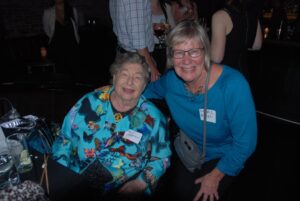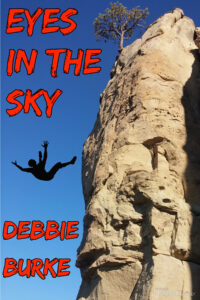By Debbie Burke
Just before the holiday break, TKZ regular Steve Hooley posed a question about public speaking for new authors. He asked:
“I would love to see some discussions here, by TKZ’ers, on the ins and outs, strategies, fine points, etc. etc. of public speaking as part of the marketing of books.”
Glossophobia or the fear of public speaking affects an estimated 75% of people…the other 25% just won’t admit to it!
TKZ’s James Scott Bell and John Gilstrap are seasoned public speaking pros and John discussed the subject in this excellent 2017 post.
I’m writing from a slightly different slant as a relative novice, dealing with newbie problems. I’m fortunate to have a mentor in Susan Purvis, who’s been an educator for decades, speaking on different continents under sometimes primitive circumstances.
Here are a dozen tips I’ve stolen from Susan, mashed up with a few hard lessons I learned myself.
The first six are psychological tricks to ease the anxiety. The rest are practical suggestions to keep presentations running smoothly.
1. Start small with audiences that aren’t intimidating.
For years, I’ve taught workshops to other writers. Because I share their concerns and curiosity, I’m comfortable around them. Those talks feel less like public speaking and more like yakking with colleagues, even if they are strangers. That made the transition easier to larger groups.
Ask a group of friends, coworkers, or family to help you hone your presentation. Once you gain confidence, speaking to strangers feels less awkward.
2. Use low attendance to your advantage.
New authors are usually discouraged when they don’t draw crowds. Instead of feeling disappointed, take that opportunity to get to know your readers on a more intimate basis. Ask questions. What are their interests? What are their favorite books? Why do they love them? Listen and learn. Their likes and dislikes will help you slant future talks to engage your audience.
3. Determine who your audience is.
Steve mentioned his books are middle-grade fantasy. He might offer to talk at his grandchildren’s schools. He can discuss the writing process, where the inspiration comes from, how to world-build, etc. Teaching is not only fulfilling but offers students a different experience that opens new doors in their education. Last fall, Susan and I had a blast talking with junior high students about Nanowrimo.
4. Seek out book clubs and offer to speak to them.
Many are eager to meet the author. The book club atmosphere is less intimidating than an auditorium setting, offering a painless way to ease into public speaking, especially if wine is involved!
5. Use the buddy system.
Bring a pal. A friendly face in the audience is a big confidence helper. Start out addressing that friend as if the two of you are having a conversation. Once you overcome initial jitters then expand to eye contact with more people.
6. Tag team.
Do a joint presentation with another author. If you share a good rapport with your co-presenter, the audience picks up on that. Play off each other. Make the time fun and entertaining.
Here are the nuts-and-bolts practical tips:
7. Learn Power Point.
It’s an easy program that even non-geeks can figure out. Use lots of photos in the presentation. Audiences enjoy seeing locations of the story, maps of the protagonist’s journey, pictures of models who inspired the physical appearances of characters, etc. Even tables of information or fun facts are interesting.
Pictures serve two purposes: first, they provide visual stimulation to the audience; second, they take some of the pressure off you as the speaker since you’re not the entire focus of their attention.
8. Practice, practice, practice.
Time your presentation with a stopwatch.
While you’re speaking, advance the slides so the mechanics of talking and clicking at the same time become automatic. During the live presentation, you may need to return to earlier slides to make points or answer questions. Know the slide order so you don’t waste time madly clicking to find the right place.
9. Don’t wear pearls.
In my first presentation before a large group, I wanted to make a good appearance and dressed up with jewelry I didn’t normally wear. To my horror, every time I gestured, my pearl necklace clacked against the lapel mic. Lesson learned. Avoid dangling or noisy jewelry that interferes with the mic.
Wear comfortable, non-binding clothes. Practice in front of a mirror. Make sure you’re not flashing underwear as you gesture.
10. Dress rehearsal. Testing, testing, one, two, three.
We’ve all attended presentations where the display screen remains black as the speaker fiddles with slides. Next, he or she keeps asking, “Can you hear me?” The mic either stays silent or lets out an eardrum-splitting screech.
To avoid being that embarrassed speaker, visit the venue prior to the presentation. If possible, I go the day before. At a minimum, arrive 30 minutes early to work out the kinks. Don’t show up three minutes before your scheduled start and trust all will be well. It won’t be…guaranteed.
Bring a muffin or latte for the tech person. He or she is your new best friend.
If you use your own computer, make sure the cords have the proper connections to hook up to the venue’s system.
If available, a better option is to put your Power Point on a thumb drive. That way you can test its compatibility with the venue’s computer.
Check out the audio options—podium mic, handheld, or lavaliere. Many devices are wireless but not all. Hook up the mic and figure out if you are tethered by wire or if you can walk around.
11. Tie your book talk into a topic of current news interest.
My recent thriller, Stalking Midas, deals with elder fraud–a charming but ruthless con artist preys on seniors and she’s not afraid to kill to get what she wants.
Elder fraud is a growing problem, affecting not only the victim but families trying to protect them. I created a public service talk based on the fraudster who bilked my adopted mother. The presentation included warning signs and tips to protect oneself and loved ones, connecting the subject to parallels in the novel.
The talk has been well-received by senior communities and I plan to branch out to service organizations.
Relating your book to a timely news event accomplishes two goals—you reach audiences beyond the narrow group of your target readers. It also takes the selling pressure off.
I have trouble asking people to buy my books. But if my talk gives them value because they learned something, it’s easier to say, “Oh, by the way, my books are for sale at the table in the back.”
12. Giveaway bonuses.
People love freebies. The prize doesn’t need to be large. Susan brings a bag of wrapped candies to her talks. When she asks questions, she tosses a treat to the person who gives the correct answer. That promotes fun interaction with the audience and loosens them up.
Incorporate a contest into your talk. The winner can be random (“Who has a birthday today?”) or it can be a reward for an audience member who asks a great question or shares a fascinating anecdote.
A signed paperback copy or a gift code for a free download of your book makes a memorable prize.
Generally, the more interaction a speaker has with the audience, the better received the presentation is.
~~~~
How about you, TKZers?
What scares you the most about public speaking?
Do you have a favorite tip to ease anxiety?
~~~~
A memorial shout-out to Scottish-born author M.C. Beaton who passed away on December 30, 2019. She wrote hundreds of novels, from Regency romances to detective series. Her books have sold more than 21 million copies worldwide. Two of her characters, Hamish MacBeth and Agatha Raisin, inspired popular TV series.
I had the good fortune to meet this delightful lady in New York City in 2018. She is an inspiration to us late-blooming authors, proving age is no barrier and can, in fact, be an asset to successful writing.
Per a statement from her publisher Little, Brown: “She hated being referred to as a ‘cosy’ writer, saying that if anyone called her books cosy she’d give them a Glasgow Kiss.”
Gotta love that spirit!
~~~~
Eyes in the Sky, book #3 in the series Tawny Lindholm Thrillers with a Heart by Debbie Burke, is now available for pre-order (publication date January 23, 2020) at this link.






I taught 7th, 8th, and 9th graders. Very little scares me. But good advice. My only “tip”, based on a pet peeve, is when the talk comes off as over-rehearsed, or the speaker is obviously reading verbatim from notes. It should sound natural, not scripted.
Terry, that’s definitely a baptism by fire!
Sounding conversational, not canned, is key. Thanks for adding a great point!
Make that a part of your practice. I knew a speaker who gave the same talk every week to a different audience. He hit the same points every time, in the same order. But he had a relaxed style so he sounded like the groups favorite uncle no matter where he was.
Sage advice. I’m with Terry. I pastored a church right out of college—I was 22 and my congregation averaged 75 (mostly retired school teachers—no critics there, LOL) so little scares me.
In regards to mics, one other important item is voice projection. This cuts both ways. I’ve never needed the mic even in larger rooms, so I have to watch my voice when I’m wearing a mic so I don’t blow folks away. Similarly, soft spoken folks need to be conscious of how their voice projects. That’s one of my pet peeves—the speaker you can’t hear even when using a microphone.
Whoa, Douglas! That’s a tough crowd. Did your sermons ever come back with red pencil marks?
Thanks for bringing up voice projection. I tend toward too soft and try to remember to ask right away, “Can you hear me?”
No, but I was asked to practice my signature 50 times. My wife still has that as a (not so funny) funny memory.
Funny to your wife; to you, not so funny!
All good tips, Debbie. And speaking of pearls — do dress up. No sweatpants and T-shirts. The audience will take you seriously if you look professional.
Thanks, Elaine.
Dress as if you’re going to a job interview. Then I think of recent job seekers I’ve seen. Wouldn’t be caught dead in Wally World in their duds!
Alton Brown (Food TV) wore Hawaiian shirts on the air because they wouldn’t rub his mic and make strange sounds.
Debbie, what great advice. I especially agree with testing everything carefully.
I’m one of those people who double- and triple-checks everything. But I still had an embarrassing moment when I gave my first talk at a library about my book. The library provided me with a meeting room to seat about thirty people and a large-screen TV I could HDMI my powerpoint presentation to. The powerpoint was a series of slides with an embedded video. The tech guy helped me set up and I checked that the slide presentation worked. Then some friends walked in and I started talking to them and didn’t check the sound on the video.
You can see where this is going. When I got to the video in the presentation, there was no sound and the tech guy had absconded with the remote. I had to fiddle with the unfamiliar on-board TV menu to get some sound, all the time with my back turned to the audience!
I’ve given the same presentation several times since then, always with different projection equipment, and I’m very careful to check the entire thing out before the audience starts to arrive!
Once burned …
Thanks, Kay.
It’s easy to get sidetracked by friends and attendees b/c, of course, you want to be friendly to the audience.
No such thing as too much checking, esp. where technology is concerned.
Excellent advice, every one of them! I’m lucky, I’ve got a co-author but we also do separate gigs. I esp agree with these:
Power point: If you can do it, do it! It helps you with material and audiences like it. Show slides of places that inspired your locations. Show your cluttered office! (big laughs usually). Show things that you use to work (ie plot boards etc.) cuz audiences are fascinating with the nuts and bolts of your creative process. Show cover designs that were rejected compared to your new one and talk about why it works (or better yet, ask the audience). Involve them in the talk.
Do a small giveaway. Kelly and I always prepare a raffle basket of local geegaws, bookmarks, books and a bottle of wine or something. It’s a nice way to close the evening.
Be yourself! But don’t apologize ahead of time saying how nervous you are or what a bad public speaker you are.
Sometimes, taking questions DURING your gig helps spur things on. It often gives me material I hadn’t thought about. Being spontaneous is never bad.
Keep it on the shorter side. And watch for the old dude who nods off. He is a good barometer. 🙂
Great additions, Kris! Love the idea of PP slides showing various cover drafts.
Yup, keep your eye on the nodding old dude.
If you are extremely nervous and you are giving a presentation, write out the first bit so you can read it to calm down. After that, just have the important points and structural elements written down. Use a huge font and heavy-weight paper for your notes.
Almost everyone is there because they want to be there so they will be on your side, especially if you tell them you aren’t an experienced speaker. Since public speaking is higher on most people’s “things I fear” lists than snakes, spiders, and clowns and readers tend to be empathetic, they will be on your side.
Huge font, YES! Thanks, Marilynn, I forgot to mention that.
Great point that your audience *wants* to be there. Either they have read your book and are interested in learning more or they haven’t read your book and are interested in learning more.
Make that a part of your practice. I knew a speaker who gave the same talk every week to a different audience. He hit the same points every time, in the same order. But he had a relaxed style so he sounded like the groups favorite uncle no matter where he was.
Everyone’s favorite uncle (or aunt) is a great style to aspire to.
In real life I am an IT guy. Bring your own dongles. Especially if you are a MAC person. From your laptop to HDMI and VGA is a must. You may want to bring your own extention cord as well.
And for sure, your presentation should be on your laptop, a cloud drive and an USB drive. Trust your puter geek.
Alan, I appreciate people like you who work ‘puter magic for techno-impaired people like me.
Debbie, Thanks! Thanks! Thanks!
Great post. I’m sorry I didn’t find it until this morning. My daytime job usually keeps me from reading the TKZ posts until late at night.
I love all the suggestions and ideas for dealing with glossophobia. I’m book marking this post, printing it out, and studying it.
I really appreciate your post!
Steve, you are so welcome!